The Canadian Acason Lorries.
Page 13

If you've noticed an error in this article please click here to report it so we can fix it.
A Good Range of Industrial Chassis, Manufactured in Walkerville, Ontario, and Placed on the Market Here by the British American Import Co.
Only landed on Saturday last, the first example of the commercialvehicle models known as the Acasons was examined and submitted to a short test by a member of our staff during the week-end. This part icular machine was that scheduled as a 31-tonner. It is presumably intended to accommodate a net load of 70 cwt., but its general structural appearance yields the impression that this is a somewhat modest rating. The full load range is listed as : 1 ton, 2 tons, 31 tons and 5 tons ; they are all wormdriven.
We hope before long to be afforded an opportunity to investigate the design of the other models, but for the moment we must be satisfied to describe, as briefly as possible, the single example that has been submitted to us.
The whole chassis of the 31-tonnor, then, be it said, is conceived on very sturdy lines ; if we may be permitted a slang expression, it has
plenty of beef in it." Its principal constructional features consist. of an amply-sized Waukesha motor, a single-disc clutch, a four-speed. gearbox, a long propeller shaft, and a Sheldon worm-driven back axle.: The standard 3?i-tonner has an engine, the Waukesha, which, we are told, has considerable reputation in Canada and U.S.A., and we can, from our own short experience of it, believe that this is well grounded. It has a relatively long stroke, the bore being 41 ins, and the stroke 5/ ins., and yields the impression of clean design and good accessibility, the latter a characteristic which is not invariably the accompaniment of attempts to re
duce the number of outward and visible components to a minimum. The cylinders are cast in pairs and the valves are all on one side. Practicable inspection doors and cover plates for crank chamber and valve motions respectively are provided. Lubrication is forced, and a float tell-tale gauge gives indication of effective circulation while the engine is running. Bosch dual ignition is fitted. The drive is a straightforward one, a single-disc, dry-plate, Raybestos-lined clutch transmits the power to the ordinary selective gearbox, the operative gear for the latter being centrally placed and, of course, built direct on to the box. The hand-brake lever is also located centrally by the side of the change-speed lever.
In this preliminary examination we did nothave the opportunity to examine the internal arrangement of the gearbox,owing to the fact that the test seat prevented our getting at it, but in operation we found that the gear changes could be made with great facility and quite sweetly both up and down. The particular model we examined had a very low final reduction, something well in excess of 11 to 1, and with an unusually powerful engine and the governor set to cut out at a moderate engine speed, the net rate of travel on the road was only a slow one, arid, without a load, did not permit really adequate judgment to be formed of the machine's full pulling capacity. There is no doubt, nowever, that it is a powerful model, and its control is undoubtedly easy in all respects. The big steering wheel and the worm and nut gear enable this heavy ma
chine to be handled with almost the same facility as a light van. The drive from the gearbox to the back axle is by means of a single, long, tubular propeller shaft of considerable diameter, and, although we are informed that this particular model is running in considerable numbers on the other side of the Atlantic, and that no trouble has been experienced in respect to the whirling of this shaft, there is little doubt that the contemplated modification, whereby a centre bearing and two universal joints will divide this shaft, will be advantageous. It will suffice, in this connection, to recall the -example of the de Dio-n motorbus chassis, the later models all had divided shafts.
The back axle is, as we have said, of the Sheldon type. This is a component which has been described by us in connection with quite a large number of recently-imported American chassis. One of the photographs shows its massive construction. The general arrangement of the worm and wheel, the differential gear and the shaft drives, as well as the special form of construction of the casing, are familiar to *most of bur readers. The brakes are all on the back wheels, and are of the internal-expanding band type.
We shall look forward to a test of some magnitude with a full load, when we anticipate that this model will yield quite a satisfactory demonstration. The prices of the Acason chassis with tires, delivered in London, will be as follow : 1-ton, £385; 2:1-ton, £560; 2750. The price of the 5-tonner is not yet fixed.






















